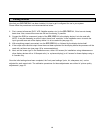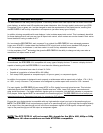
When you are installing the processor for the first time, the first order of business is to define what type of
screen will be used with this system. If a 1.78:1 (16:9) or 1.85:1 screen is used, highlight 16:9 SCREEN and
press ENTER. If a standard 4:3 screen is installed, highlight 4:3 SCREEN and press enter. However, if your
display is a native 16:9 aspect ratio (such as most plasmas), you only need to select the actual resolution of
the device. The PFP-7/PFP-11 will automatically switch itself to the proper mode.
The purpose of defining the screen type is to tell the processor how to create aspect ratios (see page 27 for
a definition of aspect ratios). For example, on a 16:9 screen, the letterbox and anamorphic aspect ratios will
use the entire 16:9 screen, and the 4:3 aspect ratio will be displayed in the center of the 16:9 screen (you'd
have 'black bars' on the left and right sides of the image).
On the other hand, on a 4:3 screen, the 4:3 aspect ratio would fill the screen, but the letterbox and
anamorphic aspect ratios would be displayed in the center of the screen vertically (there would be 'black
bars' on the top on bottom of the image).
Important note on aspect ratios for 4:3 screens: If 4:3 SCREEN is selected, the only way the processor
will provide all three aspect ratios is if one of the FIXED PIXEL scan rates are selected
(i.e. 1024 x 768). The processor will NOT provide three aspect ratios on a 4:3 screen if 480p, 540p, 600p or
720p are selected. The reason for this is that CRT projectors will provide the best resolution if two separate
memories are created by the projector itself, one for anamorphic, one for full 4:3. This way, the CRT projec-
tor can provide the maximum number of lines of resolution on either aspect ratio since it is simply compress-
ing a 4:3 image to an anamorphic image. Therefore, Runco recommends that the CRT projector create the
aspect ratios on 4:3 screens (if possible) for best results.
For fixed pixel displays, the number of pixels cannot be changed nor do many of the displays provide the
ability to create aspect ratios. Therefore, the PFP-7/PFP-11 will provide three full aspect ratios for fixed pixel
displays (WHEN a fixed-pixel scan rate is selected) for use on 4:3 screens.
In any event, if 16:9 SCREEN is selected, the PFP-7/PFP-11 will provide three aspect ratios regardless of
the selection of the scan rate type or display device used.
SCAN RATE is how many lines of resolution can be output in a single image. For example, 540p means that
there are 540 visible lines of resolution, and 'p' means the signal is PROGRESSIVE. A Progressive output is
where ALL lines of resolution will be displayed during each frame as opposed to an INTERLACED signal,
which only displays half the lines of the frame during one field and the other half the next. Progressive
outputs are far better than Interlaced outputs as all lines of resolution are always displayed, and fixed-pixel
displays produce far better results when using a progressive signal. The fixed-pixel outputs are also progres-
sive, but are referred to in PIXELS (Picture Elements) as opposed to the actual number of lines of resolution.
This is because fixed-pixel displays are referred to in their native resolution in pixels, i.e. 1024 x 768
(meaning 1024 vertical rows of pixels and 768 horizontal rows of pixels).
Selecting a scan rate (resolution) for your display device is an extremely important task. The first thing that
should be done is to determine what resolution will provide the best results for your display. The following
are some guidelines that will assist you in determining the best possible results for your type of projector.
18
Screen Type
Scan Rate/Resolution


















